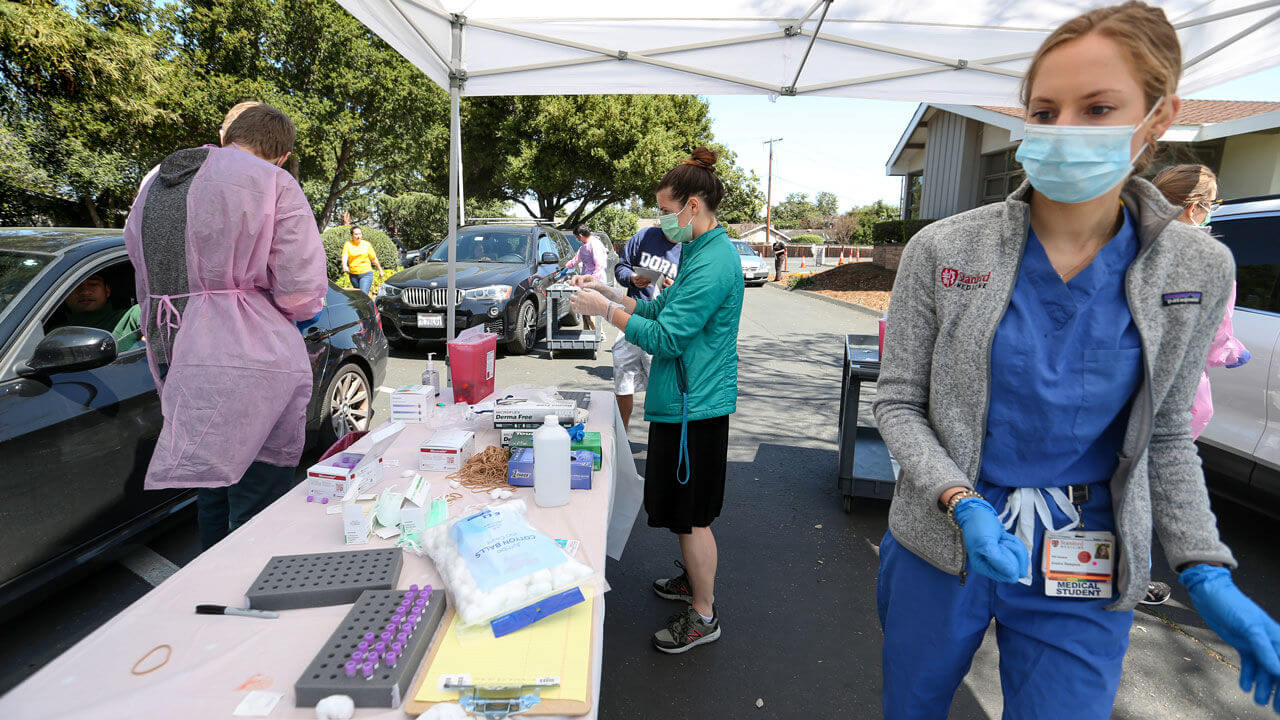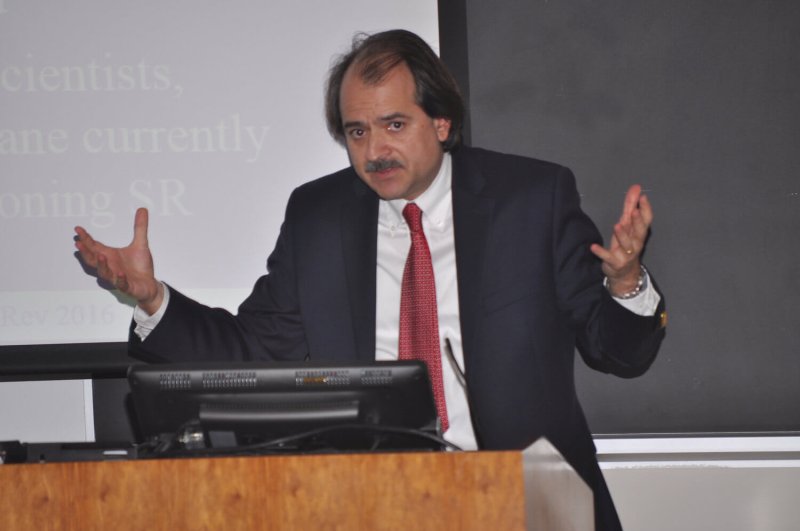In mid-March, the Stanford University scientist John Ioannidis wrote a short, viral essay for STAT arguing that the global response to the Covid-19 pandemic could be “a once-in-a-century evidence fiasco.” Without more data about the virus’s spread, Ioannidis, a professor of medicine, epidemiology, and population health, argued, the lockdowns in place in much of the world may not be justified. Covid-19 infections could be more widespread, and less lethal, than many experts feared.
Over the years, Ioannidis has earned accolades from his colleagues for his sharp, reasoned skepticism of sloppy research practices and unsupported assertions. His Covid-19 claims, though, have earned him vigorous pushback from many of his fellow scientists, who argue that, while he may be correct, Ioannidis is getting out ahead of the data — and likely understating the risks of Covid-19.
At issue here is a simple question: How many people actually have Covid-19? Ioannidis and other researchers from Stanford tried to answer that in a draft paper, or preprint, last month. Other experts began pointing out problems in the study, raising concerns about statistical errors, possible issues with a Covid-19 test kit, and shoddy sampling technique.
Undark published a story about the controversy late last month. Ioannidis did not respond to multiple requests for comment before publication. But, less than an hour after the story went up, he sent me a warm note expressing appreciation for the scientists who had criticized him. We arranged a time to talk.
A few weeks later, the team released a revised version of the paper. The new draft, which, like the original version, has not yet received formal peer review, softens some of the more controversial claims, and acknowledges more uncertainty about the true number of infections.
The following interview — which covers the papers as well as Ioannidis’ appearances on partisan television — has been edited for length and clarity.
Undark: What kind of responses have you been getting so far to the revised draft?
John Ioannidis: Well, we’ve heard from several people. And I think that they’re happy that we have addressed the main issues that were raised on the first round. I also saw that [Columbia University statistician] Andrew Gelman, who was probably the most critical voice in the first round, has posted his appraisal of the revised version, which I think is very reasonable.
It’s hard to recall another paper that has been so extensively peer reviewed. [He laughs]. And lots of accounts were very useful and very constructive. The revised version has tried to address all the major concerns. I think the results are still very robust.
But it’s a single study. You can never say that a single study is the end of the story. You need to see all studies that are done, and by now there’s more than a dozen serology studies, and I think they pretty much paint the same picture.
UD: How so? In terms of estimates for how many infections there are, and what the infection fatality rate actually is — there still seem to be some substantial differences.
JI: Yeah, but this is entirely expected. Infection fatality rate is not like Avogadro’s number. It’s not a constant, like in a chemical experiment, the Km of an enzyme reaction. It’s affected both by how you count the [numerator] and how you count the denominator, and who are the people in the [numerator] and who are the people in the denominator. So, the case mix is very different in different locations. And the way that the serious cases were managed, or could be managed, is very different in different locations.
So, depending on the setting and the population, the infection fatality rate may be from far less than influenza to far more — from the mild infection all the way to “This is disaster.”

UD: The revised draft has a new line that says, “Our prevalence and [infection fatality rate] estimates do not advocate for or refute the usefulness of any nonpharmaceutical interventions.” What do you think are policy implications from this study?
JI: Our point was to really just present the results of a scientific study. There are policy implications, of course, from any scientific study, especially from one that tries to address such an important question, but I’m afraid that many people just got entangled into a fight over, “So this study means that our policy is right, or our policy was wrong.” So then, “You’re in favor of Republicans or Trump, or you’re in favor of…” [laughs]
We felt it’s important to dissociate the specific paper from making policy recommendations, because this is taking things to a different level. Now, if you ask my opinion about whether it does have policy recommendations or implications separate from the study, I think what it says is that this is a very common infection, and very often it is asymptomatic, so it goes below the radar screen. If you just wait for people to show up to get tested and then you track the contacts, that’s not going to work, because you will miss the majority, probably the large majority, of people who will just not show up.
I just didn’t want us to see that study as being a test of the hypothesis, “Did lockdown work?” That’s not what the study did. That was not the intention. It was trying to get a particular piece of information, and trying to do that as carefully as possible, with all the limitations that exist in these types of surveys.
UD: The day the study came out, one of your coauthors published an op-ed saying that the study suggests lockdowns might be too strict. That same week, you and some of your coauthors were talking to the media about policy implications. How is that not making it political?
JI: You’re right about that. But at the same time, I want to give a little bit of a different perspective. So we did this study — the samples were run in the first days in April. And we were very careful not to say anything in the news, not to appear and make statements about the study until we had a full paper, written up and deposited.
[Compare that] with what practically every other study did, where they completely rushed to press release and press conferences and appearing in the news, like the same day that they got the results.Our stance was — and this is entirely aligned with my beliefs — this is important science. It can have repercussions, there’s no doubt about that.
So it is important to not just go and make press releases, but really write out the full paper — admittedly without the appendices, which we added in that second version.
This was something that was not possible to just hide it under the carpet. It was a major finding, and I worried that it would be misinterpreted in different ways. So, yes, I did show up on Fox, I did show up on CNN. … You know, on BBC. Does it mean that I have a conservative agenda if I appear on Fox, or that I have a Democratic agenda if I appear on CNN? I think that’s [laughing] just a complete, complete, complete misunderstanding. I’m just a scientist. I have no political party affiliation and absolutely no interest to turn this into a political debate, or to have a political agenda supported.
UD: I’ve seen your work being widely cited by people — including Fox News’ Tucker Carlson, who had you on as a guest — who are saying that the pandemic is not that serious, that it’s been overblown.
JI: I think that every citizen has the right to read science and try to make some sense of it. I cannot stop people’s interpretations of scientific findings, and it would not be appropriate for me to do that. So, yes, different people from different ideologies and from different backgrounds will read these results in different ways. But, this is not necessarily my reading or my interpretation. To be honest, as a scientist, I prefer to offer the data and try to be as calm as possible.
I think the main question is, should I or others, not talk to anyone — either Fox or CNN or BBC or Der Spiegel or Reuters or whatever? In principle, I have a problem with this perspective. It think that it creates a notion that scientists should not present the work. If you see some of these interviews — I mean, you mentioned Tucker Carlson, you can see my interview. And it’s obvious that I do not agree with lots of things that Tucker Carlson was proposing. At the same time, when he says that this virus is less lethal than we thought, this is accurate. It’s not who is saying it. It is whether this is an accurate statement or not. We started thinking that one out of 30 people will die. You know, when the [World Health Organization] made the announcement.
UD: Who thought that? The WHO said that 3.4 percent was the case fatality rate. Epidemiologists I’ve talked to said that it was clear the true infection fatality rate would likely end up being much lower. One scientist described the argument you’re making right now as “a straw man.”
JI: Well, let’s go back and check the exact announcement. [Note: The WHO announcement in question, from early March, specifies that “3.4 percent of reported cases have died.”] That was at the time when WHO had sent an envoy to China. And [the WHO envoy] came back and he said there’s no asymptomatic cases. Just go back and see what the statement was. He said there’s hardly any asymptomatic cases, it’s very serious and has a case fatality of 3.4 percemt.
Of course, that [fatality rate] was gradually dialed back to 1 percent or 0.9 percent. And these are the numbers that went into calculations, and these are the numbers that are still in many of the calculations, you know, until very recently.
You know, 1 percent is, is probably like the disaster case, maybe in some places in Queens, for example, it may be 1 percent, because you have all that perfect storm of nursing homes, and nosocomial infection [an infection that originates in a hospital], and no hospital system functioning. In many other places, it’s much, much lower.
I’m trying to disentangle the accuracy of a scientific statement from who is making that scientific statement. Because if we don’t agree with who is making the scientific statement, then we run the risk of attacking the science, because it was just stated by that person.
We have to be very cautious here. I think that that’s going to be highly detrimental to science. My first opening statement in my first Fox interview was that science is the best thing that has happened to humans. I’m very proud to say that again and again and again.
Michael Schulson is a contributing editor for Undark. His work has also been published by Wired, Salon, Slate, Pacific Standard, the Daily Beast, and The Washington Post, among other publications.
A version of this article was originally published at Undark and has been republished here with permission. Undark can be found on Twitter @undarkmag 































